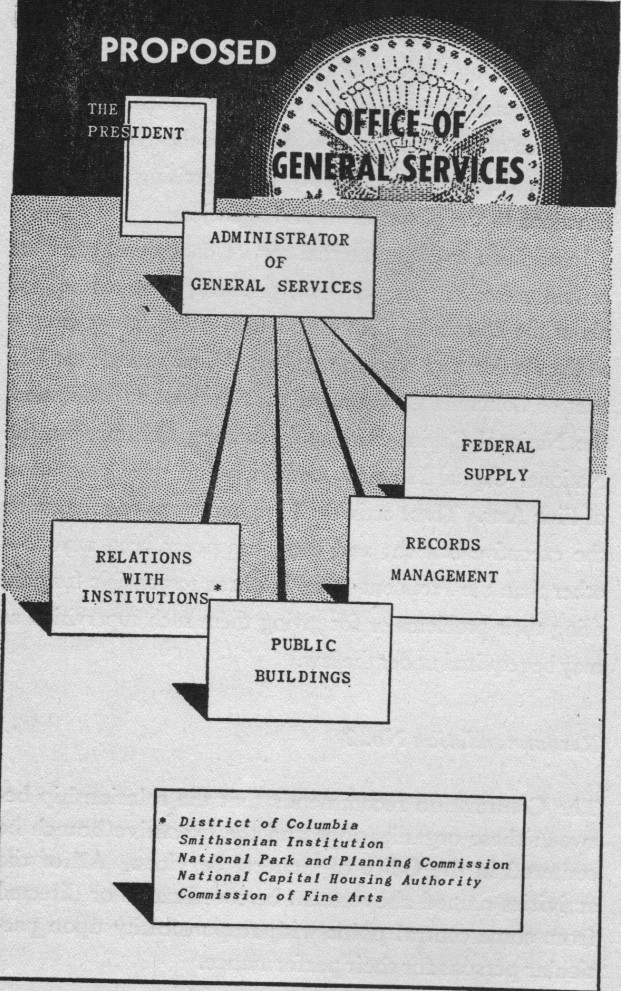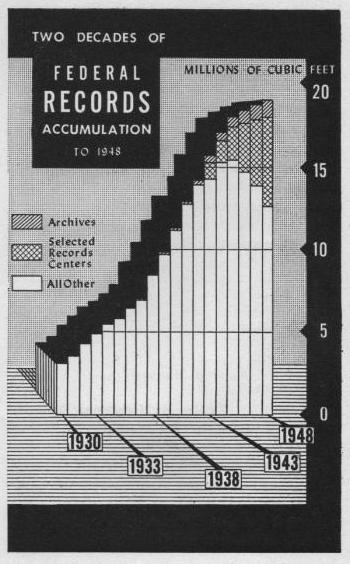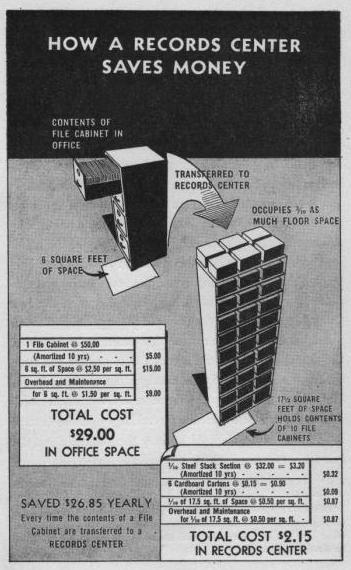|
Recommendation No. 14
Eliminate
the present surcharge levied on the price of commodities purchased
through central supply organizations for the Government as a whole
and the departments and pay the administrative costs of such
organizations through direct appropriations.
Program for Improving Federal Supply
Operations
Report on an Office of General Services
On July 7, 1947, The Lodge-Brown Act of
1947, Public Law 80-162, was signed into law and The Commission on
Organization of the Executive Branch of the Government was born.
Fortunately, President Harry Truman effectively appointed former
President Herbert Hoover as its Chairman. Either Hoover's stature
as a former President or the impossible official name of the Commission led
to its popular name, The Hoover Commission. Since Hoover chaired a
second commission under President Eisenhower, this Commission is
referred to as the First Hoover Commission. The purpose of the
Commission was to review the Executive branch of Government and to
recommend ways to reorganize and improve it. The Commission was
born in politics, operated in politics, but in the end, President Hoover
decided that the Commission's ultimate role would be to improve the
efficiency of government. When it began to issue its reports in
1949, they were met with acclaim both inside and outside of the
government. As a result, changes recommended by the Commission
were made.
This February 1949 report is the
Commission's report on an Office of General Services and it takes little
imagination to realize that it is the basis for today's General Services
Administration. Less than 5 months after this report was issued, the Federal Property and
Administrative Services Act of 1949 became law. The Federal
Property Act did not create the exact Office of General Services that
the Commission had in mind. Needless to say, anyone in federal
contracting and anyone seeking to effect change to federal contracting
should be aware of and read this report.
The report consists of two parts.
The first part deals with the creation of an Office of General Services
that includes offices for federal supply, records management, and public
buildings. The second part deals with supply activities. The
Commission included specifications, purchasing, traffic management,
inspection, property identification, storage and issue, and property
utilization in its definition of supply. Additionally, the report
on federal supply activities is supported by a task force report on The
Federal Supply System which the report refers to as "Appendix B."
Appendix B is not include in this report. However, it may be added
in the future. Finally, there are two Bureaus of Federal Supply
mentioned in this report. One is the Bureau that was abolished as
a result of this report and the other is the one that was proposed for
inclusion in
the Office of General Services. When the report mentions the
Bureau, you must determine the context in which it is used.
About The Electronic Version
This electronic version is based on the
hard copy of the Commission's report. Font is Times New Roman
which appears to be the same type used in the hard copy. Every
effort was made to match the electronic version to the hard copy.
This electronic version is copyrighted.
Bob Antonio, June 23, 2008
Owner, Wifcon.com LLC
Copyright © 2008 by Robert Antonio
|
|
|
Office of
General
Services
A report to the Congress by the Commission on
Organization of the Executive Branch of
the Government, February 1949
The Commission on Organization of The
Executive Branch of the
Government
Herbert
Hoover, Chairman
Dean
Acheson, Vice Chairman
Arthur
S. Flemming
James
Forrestal
George
H. Mead
George
D. Aiken
Joseph
P. Kennedy
|
John
L. McClellan
James
K. Pollock
Clarence
J. Brown
Carter
Manasco
James
H. Rowe, Jr.
|
Letter of Transmittal
|
Washington,
D. C.,
12 February 1949.
Dear
Sirs: In
accordance with Public Law 162, Eightieth Congress, approved July
7, 1947, the Commission on Organization of the Executive Branch of the Government submits herewith
its report on the Office of General Services, and separately, as
Appendix C, the task force report on Records Management, which is
relative to this report.
The
Commission wishes to express its appreciation for the work of its
task forces and for the cooperation of officials of the various
departments and agencies concerned.
Respectfully,
/s/
Chairman.
The Honorable
The President of the Senate
The Honorable
The Speaker of The House of Representatives
|
|
Intentionally Left Blank |
|
|
|
Next Page Is Contents |
Contents
|
Page |
|
An Office
Of General
Services
|
1 |
|
|
|
|
Supply
|
5 |
|
Records Management
|
6 |
|
Operation and Maintenance of Public Buildings
|
10 |
|
Relations With Certain Institutions |
11 |
|
Conclusion
|
13 |
|
|
|
|
Related
Task Force
Reports |
15 |
|
|
|
|
Acknowledgment
|
15 |
|
|
|
|
Charts
|
|
|
|
|
|
Proposed Office of General Services |
4 |
|
Two Decades of Federal Records Accumulation |
7 |
|
How Record Centers Would Save Money |
9 |
|
|
|
|
Report on
Supply Activities |
17 |
|
|
|
|
(v) |
An Office of General
Services
|
Three major internal activities of
the Federal Government now suffer from a lack of central direction.
These are Supply, Records management, and the Operation and
Maintenance of Public Buildings. These activities are carried
on in several places within the executive branch with varying
degrees of adequacy. While, as a general rule, centralized
direction is lacking, there are some instances of the exact reverse
of this situation in which operations are centrally controlled down
to the smallest detail.
To the general public, the "housekeeping" activities listed above
are little-known, but unless they are properly administered, the
executive branch cannot be effectively managed. Moreover, huge
sums are spent on these activities. Rents and utility services
have cost in the neighborhood of $200,000,000
in each recent year. Civilian supply purchases alone total an
estimated $900,000,000 per year, and this is
exclusive of such large items as transportation of property and
storage or handling costs.
Since these activities relate to all departments, there is only one
place in the executive branch of the Government where authority
should be vested. That is in the President, subject, of
course, to appropriate legislative directions. Yet obviously
the President personally cannot exercise this responsibility except
in most unusual circumstances.
|
|
|
|
1 |
|
The principal issue affecting
service activities: How much of any such activity shall be
centralized and how much shall be performed by the individual
executive departments and agencies?
Undoubtedly, some housekeeping services must be performed centrally
in order to avoid waste. On the other hand there is frequently
too much centralization. In a large scale effort like the
Federal Government, too high a degree of centralization of services
may result merely in congestion, red tape, and inefficiency.
When highly specialized equipment must be purchased by a single
agency only for its own use, for example, it is more reasonable and
efficient for it to develop the specifications, negotiate the
purchase contract, and inspect delivered goods.
Two important questions about these housekeeping services must be
determined. First.
Who shall decide what part of any service shall be centralized and
what part shall be left to individual operating agencies?
Second. Who shall supervise
the centralized services to make certain that they perform their
work satisfactorily? Recommendation No. 1
The Commission recommends that responsibility for these three
internal service operations should be placed in an Office of General
Services under a director appointed by the President. |
|
|
|
2 |
|
The office of General Services
should be given authority, subject to the direction of the
President, to prescribe regulations governing the conduct of these
three activities by departments and agencies of the executive
branch. However, the Office of General Services should, to the
greatest extent possible, delegate responsibility for exercising
these three functions to the departments and agencies.
In addition to these internal service operations, there are certain
miscellaneous activities, primarily centered in and about the
District of Columbia, which either report directly to the President
or report to no one. These include the District of Columbia
Government, the Smithsonian Institution, the National Capital Park
and Planning Commission, the National Capital Housing Authority, and
the Commission of Fine Arts. These activities have numerous
relations with executive branch; and there has never been anyone―other
than the President―who has been responsible for handling their
problems or for giving them such supervision as may be required
under the law.
Recommendation 2
The Commission
recommends that the relationship between these organizations and the
executive branch be centered in the Office of General Services.
All of the activities named above must be coordinated or directed
from some central point with responsibility upon particular persons
for their performance. |
|
|
|
3 |

4
|
Recommendation
3
We recommend that
the following functions, each under a director, shall be placed in
the Office of General Services.1
a.
Supply,
b. Records
Management,
c. Operation
and Maintenance
of Public
Buildings.
d. Certain
Relations with the
Smithsonian Institution, the National Parks and Planning Commission,
the National Capital Housing Authority, the Commission of Fine Arts,
and the District of Columbia.
(See chart, Proposed Office of General Services.)
We submit separately, the
task force report on the second subject as appendix "C".
The Commission's detailed recommendations on supply summarized
below are filed in a separate report.
Supply
It is proposed, as
discussed in our accompanying report, that the supply bureau in the
Office of General Services be developed primarily, although not
exclusively, for policy-making and coordination of the procurement
of supplies and other supply functions for the executive
departments.
It would assign responsibility for the purchase and storage of
commodities peculiar to the use of an agency to the agency best
suited to make such purchases or to store such com-
_________ |
|
1DISSENT:
Commissioner Herbert Hoover and Arthur Flemming have
recommended (in our report on Budgeting and Accounting) that the
Statistical and Publications units now in the Office of the Budget
should be placed in the office of General Services for reasons which
they state in that report. |
|
|
|
5 |
|
modities. It would also designate certain
agencies to purchase specified supplies for all agencies and it
would award contracts to vendors for common-use items. These
contracts would be utilized by all agencies in the purchase of such
items. The bureau would handle the purchase for small agencies
when economical to do so. It would assure systematic handling
and fundamental standards, and its objective would be to
decentralize activities into the different departments, agencies and
field office regions.
Civilians and military supply activities would be coordinated
through a Supply Policy Committee.
Recommendation No. 4
The Commission recommends that a central
Bureau of Federal Supply be created in the Office of General
Services and that the Federal Bureau of Supply in the Treasury be
abolished.
Records Management
The maintenance of records costs the
Federal Government enormous sums annually. The records now in
existence would fill approximately sic buildings each the size of
the Pentagon. (See chart, Two Decades of Federal Records
Accumulation.)
In 1948, some
18 million square feet of space were filled
with records. Our task force estimates that, on the basis of
rental value alone, the space costs for this volume of records |
|
|
|
6 |

7
|
is at least 20 million
dollars annually. The filing equipment for handling these
papers would be worth 154 million dollars at
current prices.
A new central records service is needed to consolidate and reduce
the records centers which various Government agencies now operate,
and to direct the work of these regional records centers along with
that of the National Archives in Washington.
More detailed recommendations to accomplish improved records
management have been submitted by our task force. The task
force report estimates that probably 50
percent of the total records of the average Government agency can be
eliminated from the main office with a substantial savings of
personnel, plant, equipment, and space. Every time the
contents of one file cabinet are transferred to a records center,
the Government can save approximately $27 a
year in office costs. (See chart, How Records Center Would
save Money.)
Recommendation No. 5
We recommend:
a.
The creation of a Records Management Bureau in the Office of General
Services, to include the National Archives.
b.
Enactment of a new Federal Records Management Law to provide for the
more effective preservation, management, and disposal of Government
records.
c.
Establishment of an adequate records management program in each
department and agency.
|
|
|
|
8 |

9
|
Operation and Maintenance of Public Buildings
Maintenance of buildings, allotment
of space, and moving service in the District of Columbia and in some
selected cities would be the responsibility of the third bureau in
the Office of the General Services. Its work thus relates to
all departments and agencies. it has the management of over
54 million gross square feet of
Government-owned space and over 6 million
gross square feet of leased space, of which 24
million square feet are outside the District of Columbia.
It is not proposed that space allotments in the Post Offices and
the National Military Establishment should be made by this agency
although servicing by this agency of the buildings occupied by the
Post Office and the Military Establishment is desirable. In
any event, close cooperative arrangements should be established
between this agency, the Post Office Department, and the National
Military Establishment.
It is essential in these matters that authority be expended and
that there be a central agency (a)
to prepare and issue standards of efficiency in the management of
public buildings; (b) to supervise space allotments in
Government buildings in towns where there are several large agencies
(except in buildings of the National Military Establishment and the
Post Office Department with which cooperative arrangements should be
established);2 (c) to maintain and operate Govern-
_____________ |
|
2 Dissent:
Commissioner Pollock is unable to agree with the restrictive wording
of this because he believes that the Public Buildings Administration
should have complete control over space allocations, not merely in
Washington, but throughout the Country. |
|
|
|
10 |
|
ment buildings; (d) to prepare standard
forms of leases and deeds and maintain a record of leases and
buildings owned by the Government.
Recommendation No. 6
The Commission recommends that the
administration of the functions enumerated above be placed in the
Office of General Services, but it expresses no opinion as to design
and construction of buildings, and other functions of the Public
Buildings Administration.
Relations with Certain
Institutions
THE DISTRICT OF COLUMBIA
Under the
Constitution the Congress has authority to "exercise exclusive
legislation" over the District of Columbia. The District of
Columbia Government is primarily supported by its own revenues, but
the Federal Government makes annual contributions to it. The
Federal contribution amounted to 12 million
dollars in fiscal year 1949. The budget
of the District is transmitted with the President's budget message
and appropriations for it are made by the Congress. Although
the executive branch does not directly supervise the District of
Columbia Government, departments and agencies, and the District
Government, have many mutual contacts and problems for which there
is no central clearing house other than the President himself. |
|
|
|
11 |
|
Recommendation No. 7 The
Commission recommends that matters involving Presidential action be
referred by the District of Columbia officials to the Director of
the Office of General Services.
THE SMITHSONIAN INSTITUTION
The Smithsonian Institution is one
of the great scientific museums and research institutions of the
country. It is partly endowed and partly supported
by appropriations ($2,090,000 in 1949).
The establishment has as its members the President of the United
States, the Vice President, the Chief Justice, and the members of
the President's Cabinet. The Institution is governed by a
Board of Regents, comprised of the Vice President, the Chief
Justice, three members each of the Senate and of the House of
Representatives, and six citizens of the United States appointed by
joint resolution of Congress. It cooperates with several
Departments of the Government.
Recommendation No. 8
No change is proposed in the Institution, but
when its officials need assistance from the Chief Executive of the
departments, it is recommended that they consult with the Director
of the office of General Services. |
|
|
|
12 |
|
OTHER NATIONAL CAPITAL ACTIVITIES
The following separate agencies
perform activities in the District of Columbia:
The
National Park
and Planning Commission.
The National
Capital Housing
Authority.
The Commission
of Fine Arts.
Recommendation No. 9
These agencies should report to some
responsible part of the executive branch. We recommend that
they should report to the Director of the office of General
Services. |
|
|
|
13 |
|
Intentionally Left Blank |
|
|
|
Next Page Is 15 |
|
Related Task Force Reports
The Commission has had printed
Appendix C, the task force report on Records Management.
Acknowledgment
The Commission wishes to acknowledge the
assistance of the following persons:
records management
Undertaken by
National
Records Management
Council.
Research Director
E. J. Leahy,
executive director of the Council; formerly of the National Archives
and director of Records Administration, United States Navy.
Consultants
Herbert
E. Angel, director of
Office Methods Branch, Department of the Navy.
Wayne C. Grover,
Archivist of the United States.
Robert H. Bahmer,
assistant archivist of the United States, formerly Director of
Records Management, Department of the Army.
F. M. Root,
Westinghouse Electric Co., Pittsburgh, Pa.
Edward Wilber,
director of the Division of Organization and Budget, Department of
State |
|
|
|
15 |
|
|
